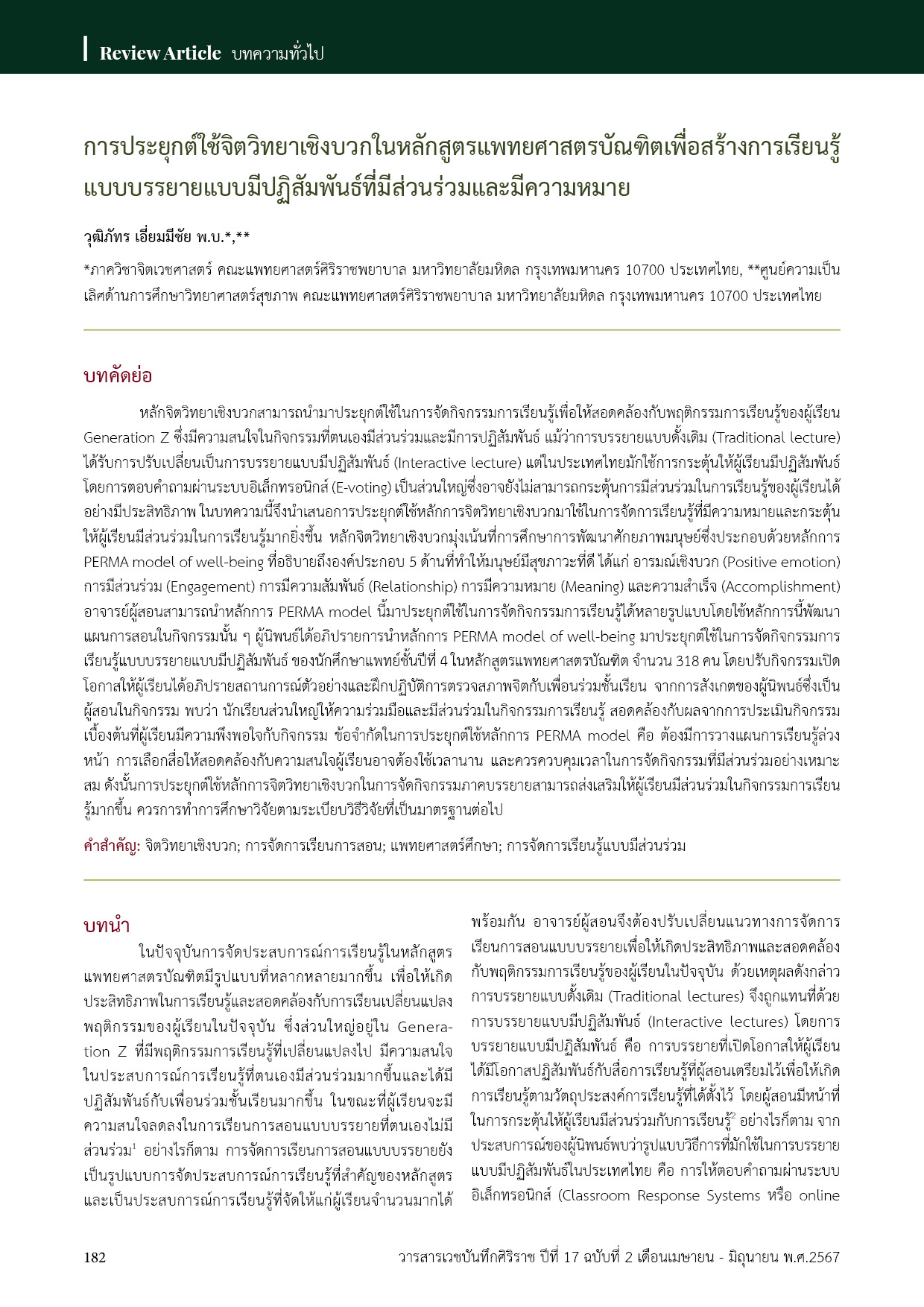Applying Positive Psychology in Medical Curriculum: Creating engaging and meaningful interactive lecture
Main Article Content
Abstract
Positive Psychology can be applied to develop learning experiences for Generation Z learners, who need actively engaging activities. Although traditional lectures have been replaced by interactive lectures nowadays, the most used interactive technique in Thailand, Classroom Response Systems or online voting, might not effectively stimulate learning. This article explains the application of Positive Psychology in interactive lectures to make meaningful learning and students’ engagement in learning processes. PERMA model is the model for increasing the well-being of humans, comprising positive emotions, engagement, relationships, meaning, and accomplishment. This model helps instructors to create various types of learning experiences. The author illustrated his experience applying Positive Psychology in an interactive lecture for fourth-year medical students in this article. The author applied Positive Psychology to change the learning experience, which previously was a didactic lecture, to more discussion in pairs and roleplay. Three hundred and eighteen students participated in this activity. The author, an instructor, evaluated this learning experience by direct observation. Most students actively participated and engaged with this activity by the instructor’s observation. Additionally, the survey showed that students were satisfied with this activity. Nonetheless, the limitations of the application are instructors have to plan the lesson in advance, spend much time selecting interesting media, and carefully manage time. Therefore, applying Positive Psychology in the lecture increases students’ engagement. Well-methodology research should be conducted to confirm the result.
Article Details

This work is licensed under a Creative Commons Attribution-NonCommercial-NoDerivatives 4.0 International License.
References
Eckleberry-Hunt J, Lick D, Hunt R. Is medical education ready for generation Z? Journal of Graduate Medical Education. 2018;10(4):378–81. doi:10.4300/jgme-d-18-00466.1
Rutgers, The State University of New Jersey. Interactive lecture strategies [Internet]. [cited 2023 Oct 22]. Available from: https://dcs.rutgers.edu/active-learning/teaching-tools/interactive-lecture-strategies Kern ML, Wehmeyer ML. The Palgrave Handbook of Positive Education. Springer International Publishing; 2021.
Bruff D. Lecturing [Internet]. Vanderbilt University; 1970 [cited 2023 Oct 22]. Available from: https://cft.vanderbilt.edu/guides-sub-pages/lecturing/
PERMATM theory of well-being and PERMATM workshops [Internet]. [cited 2023 Jul 25]. Available from: https://ppc.sas.upenn.edu/learn-more/perma-theory-well-being-and-perma-workshops
พนม เกตุมาน, สุรวิทย์ อัสสพันธุ์. จิตวิทยาเชิงบวกและการเรียนรู้ (Positive Psychology in Learning). ใน:กิตติรรัตน์ ปลื้มจิตร, บรรณาธิการ. ก่อการครู การเรียนรู้เปี่ยมพลัง:12 นวัตกรรมการเรียนรู้เพื่อครูหัวใจใหม่. กรุงเทพ:มหาวิทยาลัยธรรมศาสตร์, 2565:137-75.
Positive psychology in the classroom [Internet]. 2021 [cited 2023 Jul 25]. Available from: https://www.teachingexpertise.com/articles/positive-psychology-in-the-classroom/
Lou J, Xu Q. The development of Positive Education combined with online learning: Based on theories and practices. Frontiers in Psychology. 2022;13. doi:10.3389/fpsyg.2022.952784






